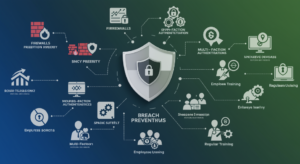AI SaaS Security: Prevent Silent Breaches in Your Stack
Imagine waking up to find that a subtle vulnerability in your AI-powered SaaS tools has led to a data leak you never saw coming. AI SaaS security is more critical than ever in today’s digital landscape, where artificial intelligence integrates deeply into business operations. In this post, we’ll explore how to identify and stop these silent breaches before they escalate, ensuring your tech stack remains robust and reliable. Have you ever wondered what makes AI SaaS security so tricky?
By focusing on proactive measures, you can protect sensitive information and maintain customer trust. Let’s dive into the essentials right away.
Why AI SaaS Security Matters in the Modern Tech Stack
AI SaaS security isn’t just about firewalls; it’s about defending against invisible threats that slip through the cracks. With AI algorithms processing vast amounts of data in SaaS platforms, even minor oversights can lead to silent breaches—those sneaky attacks that go undetected until it’s too late. For instance, a recent report highlighted how AI-driven SaaS apps are 30% more susceptible to data exfiltration due to their reliance on machine learning models.
Think about it: Your CRM or analytics tool might be using AI to predict customer behavior, but if not secured properly, it could expose proprietary data. By prioritizing AI SaaS security, businesses can avoid costly downtime and reputational damage, turning potential vulnerabilities into strengths.
Common Signs of Silent Breaches in AI SaaS
Silent breaches often start small, like unusual data access patterns or minor performance glitches in your SaaS stack. These aren’t always obvious, making them hard to spot without the right tools. A hypothetical scenario: Your AI chatbot begins responding slower than usual, which could indicate malware quietly siphoning information.
To catch these early, monitor for anomalies such as unauthorized API calls or unexpected data flows. What if a simple audit could save your company from a major headache? That’s the power of staying vigilant with AI SaaS security.
Key Risks and Vulnerabilities in AI SaaS Security
Every AI SaaS setup comes with inherent risks, from data poisoning—where attackers manipulate training data—to insecure third-party integrations. According to a study from the National Institute of Standards and Technology NIST.gov, AI systems in SaaS environments are particularly vulnerable to model inversion attacks, which can reveal sensitive user information without triggering alarms.
Another risk is the “shadow AI” phenomenon, where employees use unsanctioned tools that bypass company security protocols. Have you checked if your team is using approved SaaS apps? Ignoring these threats can lead to silent breaches that erode your stack’s integrity, but with the right strategies, you can mitigate them effectively.
How Silent Breaches Occur and Their Impact
Silent breaches typically exploit weaknesses in AI algorithms, such as poorly managed access controls or outdated encryption. For example, a breach in a popular AI SaaS platform might involve attackers using adversarial inputs to manipulate outputs, all while remaining undetected. The impact? Lost revenue, legal fines, and a loss of customer confidence that can take years to rebuild.
What’s your current approach to monitoring AI interactions? By understanding these dynamics, you can implement AI SaaS security measures that not only detect but also prevent such issues.
Proven Strategies to Prevent Silent Breaches
Preventing silent breaches starts with a multi-layered defense for your AI SaaS stack. One effective strategy is regular vulnerability scanning, which identifies potential weak points before they become problems. Here’s a quick list of actionable steps:
- Implement zero-trust architecture to verify every access request, reducing the risk of unauthorized entry.
- Use AI-specific tools for anomaly detection, like behavioral analytics that flag unusual patterns in real-time.
- Conduct routine security audits and penetration testing to simulate attacks on your SaaS environment.
By adopting these practices, you’re not just reacting to threats—you’re staying ahead. For more on zero-trust models, check out our guide on Zero-Trust Security Basics for deeper insights.
Best Practices for Enhancing AI SaaS Security
To bolster your defenses, focus on encryption and data minimization in your AI SaaS tools. Always encrypt data at rest and in transit, and limit the amount of information shared with AI models to reduce exposure. A relatable example: Think of your SaaS stack as a fortified castle—each layer of security is a wall that attackers must breach.
Additionally, train your team on AI SaaS security awareness to spot phishing attempts or risky behaviors. What steps can you take today to make your stack more resilient? Integrating these habits can dramatically lower the chances of silent breaches.

Real-World Examples and Actionable Tips
Consider a real case where a company like Zoom faced scrutiny over AI features in their SaaS platform; they enhanced security by adding robust access controls. This not only prevented potential silent breaches but also rebuilt user trust. Actionable tip: Start by mapping your AI SaaS dependencies and prioritizing high-risk areas for updates.
Another tip is to leverage automated compliance tools that align with regulations like GDPR. Have you audited your SaaS vendors lately?
Wrapping Up: Secure Your Stack Today
In summary, prioritizing AI SaaS security is essential for preventing silent breaches and ensuring your tech stack thrives. By implementing the strategies we’ve covered, you can create a safer environment that supports innovation without compromise. Remember, security is an ongoing process, not a one-time fix—what changes will you make first?
If this resonated with you, I’d love to hear your thoughts in the comments below. Share your experiences with AI SaaS security, or check out more resources on our site. Let’s keep the conversation going and protect our digital world together!
Citations
National Institute of Standards and Technology. (2023). AI Risk Management Framework. Retrieved from NIST.gov.
- Wing Security: Five AI Security Threats in SaaS
- Valence Security: Mitigating GenAI Risks in SaaS Applications
- Natty Tech: Silent Breaches Are Happening Right Now; Most Companies Have No Clue
- NordLayer: SaaS Security Guide
- KDnuggets: Always Learning: How AI Prevents Data Breaches
- Standard Beagle: Emerging AI Trends for SaaS
- Akamai Blog
- ReversingLabs: Silent Breaches and Supply Chain Security: Lessons Learned
